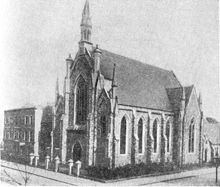
The Brotherhood Church is a Christian anarchist and pacifist community. [1] An intentional community with Quaker origins has been located at Stapleton, near Pontefract, Yorkshire, since 1921. [2]

The Brotherhood Church is a Christian anarchist and pacifist community. [1] An intentional community with Quaker origins has been located at Stapleton, near Pontefract, Yorkshire, since 1921. [2]
The church can be traced back to 1887 when a Congregationalist minister called John Bruce Wallace started a magazine called "The Brotherhood" in Limavady, Northern Ireland. Wallace was influenced by the views of Henry George and Edward Bellamy. In 1891 Wallace moved to London and took over a derelict church in Southgate Road, Hackney, naming it "The Brotherhood Church." The Russian Social Democratic Labour Party used the building in 1907 for their 5th Congress. [3]
Subsequent communities were established by a Tolstoyan named John Coleman Kenworthy in Croydon, Surrey, in 1894 and Purleigh, Essex, in 1896. [3] Residents at Croydon and Purleigh included Aylmer and Louise Maude and Vladimir Chertkov. However, both these communities ceased shortly after they were established, as Kenworthy fell out with Chertkov and argued with Aylmer Maude over the English translation of Tolstoy's works. Based on a letter from Tolstoy, Kenworthy was under the impression that he had exclusive rights over some of Tolstoy's texts. [4] Aylmer Maude, on the other hand, believed the reason for the failure of the colony was due to Kenworthy's autocratic and irresponsible behaviour. [5]
In 1897 several members, some from a Quaker background, moved to Leeds. The receipt of a legacy enabled the group to relocate to a seven and a half acre smallholding at Stapleton in 1921. [2] [6] Another Purleigh splinter group established the Whiteway Colony in 1898, funded by a Quaker journalist. [3]
John Bruce Wallace went on to become an early resident at Letchworth in Hertfordshire where he held religious gatherings each Sunday in the Howard Hall. After the establishment of the Brotherhood Church Wallace founded the Alpha Union Society which held many of its meetings at the recently built The Cloisters in Letchworth. [7]
In 1934, the church was demolished and now a block of flats stands on the site. [8]
The Stapleton Colony are vegetarian, grow much of their own organic food and attempt to live independently from the government. [9] They are affiliated to the Peace Pledge Union, Campaign for Nuclear Disarmament and War Resisters' International. [10] Residents have included Len W. Gibson (1919–2007) who was a lifelong peace campaigner and conscientious objector. [11]
Anarcho-pacifism, also referred to as anarchist pacifism and pacifist anarchism, is an anarchist school of thought that advocates for the use of peaceful, non-violent forms of resistance in the struggle for social change. Anarcho-pacifism rejects the principle of violence which is seen as a form of power and therefore as contradictory to key anarchist ideals such as the rejection of hierarchy and dominance. Many anarcho-pacifists are also Christian anarchists, who reject war and the use of violence.

The Tolstoyan movement is a social movement based on the philosophical and religious views of Russian novelist Leo Tolstoy (1828–1910). Tolstoy's views were formed by rigorous study of the ministry of Jesus, particularly the Sermon on the Mount.
Christian anarchism is a Christian movement in political theology that claims anarchism is inherent in Christianity and the Gospels. It is grounded in the belief that there is only one source of authority to which Christians are ultimately answerable—the authority of God as embodied in the teachings of Jesus. It therefore rejects the idea that human governments have ultimate authority over human societies. Christian anarchists denounce the state, believing it is violent, deceitful and idolatrous.

An intentional community is a voluntary residential community which is designed to foster a high degree of social cohesion and teamwork. Members typically unite around shared values, beliefs, or a common vision, which may be political, religious, spiritual, or simply focused on the practical benefits of cooperation and mutual support. While some groups emphasise shared ideologies, others are centred on enhancing social connections, sharing resources, and creating meaningful relationships.
What Is Art? is a book by Leo Tolstoy. It was completed in Russian in 1897 but first published in English in 1898 due to difficulties with the Russian censors.
Nonresistance is "the practice or principle of not resisting authority, even when it is unjustly exercised". At its core is discouragement of, even opposition to, physical resistance to an enemy. It is considered as a form of principled nonviolence or pacifism which rejects all physical violence, whether exercised on individual, group, state or international levels. Practitioners of nonresistance may refuse to retaliate against an opponent or offer any form of self-defense. Nonresistance is often associated with particular religious groups, such as Anabaptist Christianity.

Whiteway Colony is a residential community in the Cotswolds in the parish of Miserden near Stroud, Gloucestershire, United Kingdom. The community was founded in 1898 by Tolstoyans and today has no spare land available with over sixty homes and 120 colonists. At the beginning, private property was rejected and personal property shared; however, today the colonists' homes are privately owned and sold at market value. As the colony abandoned Tolstoy's philosophy it has been regarded by many, including Mohandas Gandhi who visited in 1909, as a failed Tolstoyan experiment.
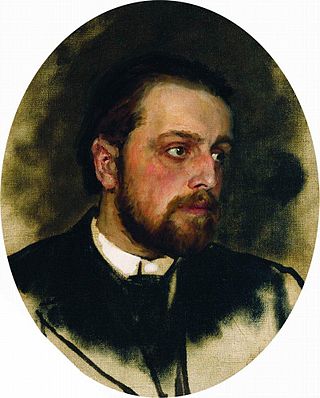
Vladimir Grigoryevich Chertkov (‹See Tfd›Russian: Влади́мир Григо́рьевич Чертко́в; also transliterated as Chertkoff, Tchertkoff, or Tschertkow was one of the editors of the works of Leo Tolstoy, and one of the most prominent Tolstoyans. After the revolutions of 1917, Chertkov was instrumental in creating the United Council of Religious Communities and Groups, which eventually came to administer the Russian SFSR's conscientious objection program.
The Life and Labor Commune was a Tolstoyan agricultural commune founded in 1921 and disbanded as a state run collective farm on 1 January 1939. The commune was founded near Moscow but was later resettled in central Siberia, not far from Novokuznetsk. At its peak, it reportedly had as many as 1,000 participants. Throughout its existence the members of the commune were persecuted by the Bolsheviks, both for refusing to enlist or support their war efforts as well as for organizing themselves communally outside of the approved state structure.

Aylmer Maude and Louise Maude (1855–1939) were English translators of Leo Tolstoy's works, and Aylmer Maude also wrote his friend Tolstoy's biography, The Life of Tolstoy. After living many years in Russia the Maudes spent the rest of their lives in England translating Tolstoy's writing and promoting public interest in his work. Aylmer Maude was also involved in a number of early 20th century progressive and idealistic causes.

The Cloisters in Letchworth Garden City, Hertfordshire in the UK was built in 1905 as an open-air school dedicated to Psychology and where students were taught skills from the Arts and Crafts movement. After a period of neglect during World War II The Cloisters became the North Hertfordshire Masonic Centre in 1951.
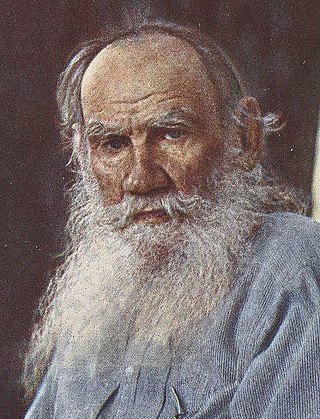
Count Lev Nikolayevich Tolstoy, usually referred to in English as Leo Tolstoy, was a Russian writer. He is regarded as one of the greatest and most influential authors of all time. He received nominations for the Nobel Prize in Literature every year from 1902 to 1906 and for the Nobel Peace Prize in 1901, 1902, and 1909.

Purleigh is a village on the Dengie peninsula about 4 miles (6.4 km) south of Maldon in the English county of Essex. The village is part of the Purleigh ward of the Maldon district.
My Life is the published memoirs of Sofia Andreevna Tolstaya, the wife of Leo Tolstoy. Her manuscript lay dormant for almost a century.

The Stapleton Colony, based in Stapleton, North Yorkshire, is a Christian pacifist and anarchist community, and the only remaining colony of the Brotherhood Church. By 2016 the population of the colony had declined to four residents.

Utopian socialism is the term often used to describe the first current of modern socialism and socialist thought as exemplified by the work of Henri de Saint-Simon, Charles Fourier, Étienne Cabet, and Robert Owen. Utopian socialism is often described as the presentation of visions and outlines for imaginary or futuristic ideal societies, with positive ideals being the main reason for moving society in such a direction. Later socialists and critics of utopian socialism viewed utopian socialism as not being grounded in actual material conditions of existing society. These visions of ideal societies competed with revolutionary and social democratic movements.
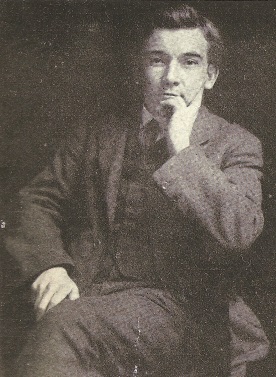
Charles William Daniel was an English publisher and writer who did much to disseminate Tolstoyan and pacifist ideas, and ideas about food reform and alternative medicine, in the first half of the twentieth century. During the First World War he was twice prosecuted for works that he published. The first prosecution was for his own pamphlet, The Knock-Out Blow; when fined he refused to pay and was imprisoned. Later he was prosecuted for publishing the controversial novel Despised and Rejected by Rose Allatini, and was again fined. The magazines that he edited and published included work by many of the advanced thinkers of the time.
Henderson's, better known as The Bomb Shop, was a bookshop at 66 Charing Cross Road, London known for publishing and selling both radical left and anarchist writing and modernist literature. The shop was founded in 1909, and was a father and son operation run by Francis Riddell Henderson, formerly the London representative of Walter Scott Publishing. The shop was bought by Eva Collet Reckitt, and became the first of the Collet's chain of left-wing bookshops.
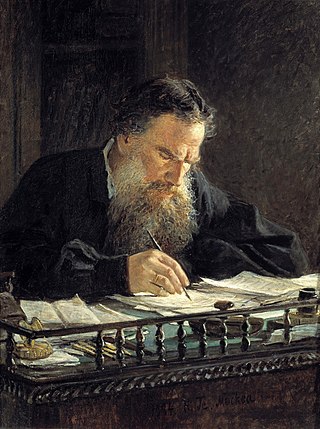
"A Letter to the Liberals" is an 1896 open letter by Leo Tolstoy denouncing not just Liberals, but all political factions that strive to exert political power over the masses. It is directed to Alexandra Kalmykov (1849-1926), a pedagogue who supported the aristocracy. The closing of a national literacy committee was the inspiration that brought Tolstoy to write it and it was written in an atmosphere where the Nihilist movement and the anti-aristocratic agitation was in full swing.
The Brotherhood Church originated as a Christian anarchist pacifist community
{{cite web}}: CS1 maint: bot: original URL status unknown (link)He fell out with Chertkov in England, and also quarrelled with Aylmer Maude over the English translation of Tolstoy's works
Tolstoyism and Tolstoyan colonies
British Utopian Experiments (1325-1945), Yorkshire